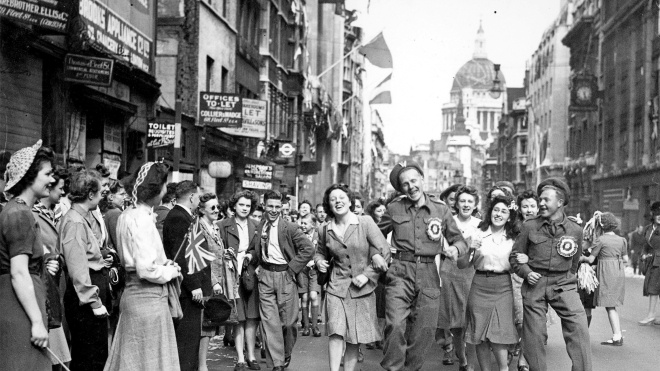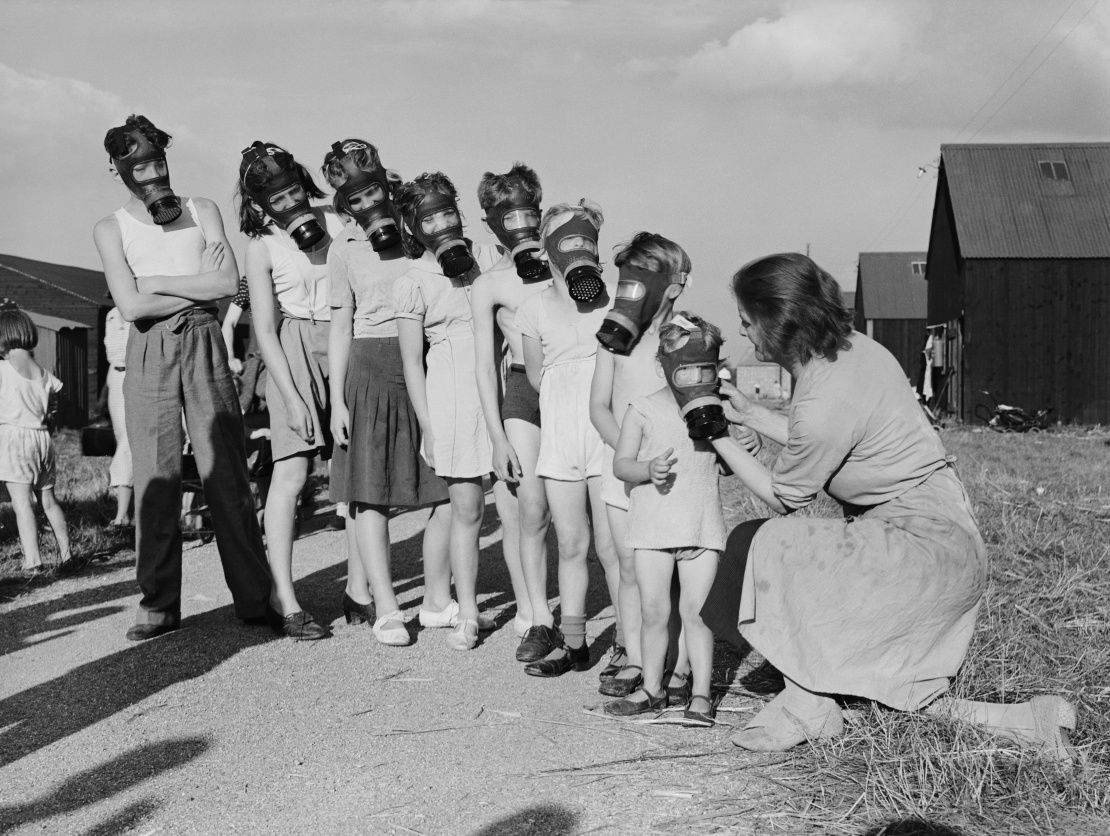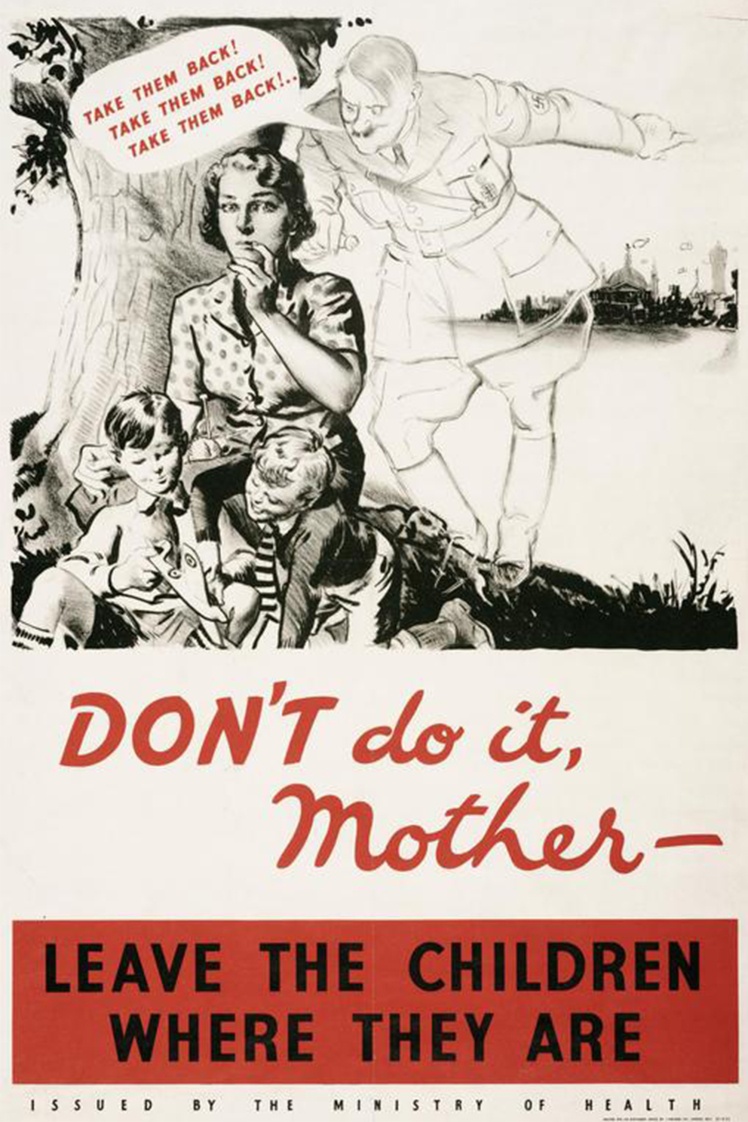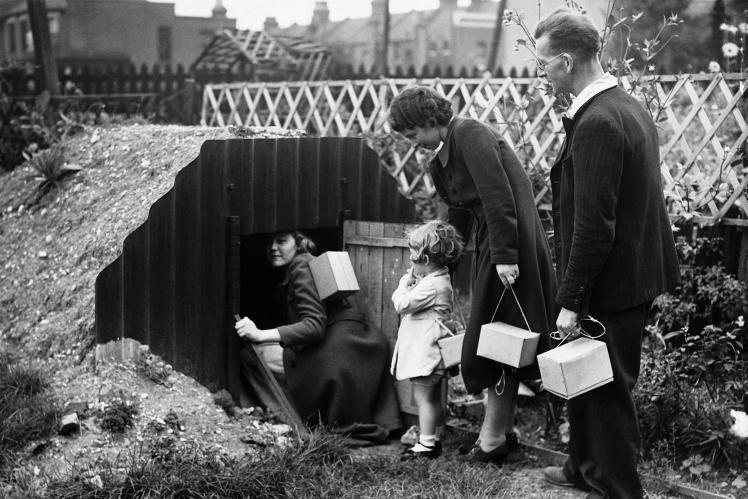Britain began preparing for World War II at least a year before it actually began. And this referred not only to the army and armaments, but also to the rear. As early as 1938, the British began to be taught how to behave during air raids and gas attacks. In London, the stations of the first and one of the worldʼs largest subways were arranged for bomb shelters.
Children of seasonal farm workers in Britain learn to use gas masks, August 29, 1939. Itʼs just a few days before the Second World War.
Getty Images / «Babel'»
On September 1, 1939, Hitler invaded Poland, starting World War II. Plans for the rear were launched in Britain on the same day, although the country officially declared war on Germany two days later, on September 3.
Firstly, on the same day, September 1, the rear started practicing light masking in case of German air strikes. Restrictions were very substantial, a fine could be issued even for a match lit in the dark. Later, the rules were relaxed slightly.
It quickly became clear that the British were not ready for this: only by January 1942, one in five people was injured in one way or another, wandering in the dark. The number of road accidents has risen sharply: in September 1939, 1,130 people died in car accidents compared to 544 a year ago. And the number of robberies, thefts, frauds, rapes, murders, and other crimes has increased. So at first the decision to cut off electricity caused mass discontent in society.
An air raid inspector sets a light-off indicator in London during World War II, November 1939.
Getty Images / «Babel'»
Getting somewhere by train was another challenge. The number of passenger trains was reduced to a minimum, and restaurant cars were almost completely removed. As well as all the signs at the stations in case of German invasion. This only increased the confusion among passengers who had to travel in crowded trains.
From 1939, the British began to have problems with fuel. In 1942, they could not go anywhere by their cars, because gasoline was given only to the military. And the government only added fuel to the fire by launching an ad campaign under the slogan "Is your journey really necessary?"
A British poster from the Second World War reminded passengers not to take the railway unnecessarily in time of war.
Getty Images / «Babel'»
Before the war, about 70 percent of Britainʼs food was imported, leaving behind about 50 million people to be fed. One of the main strategies of the Germans in the battle for the Atlantic was to attack, in particular, the merchant ships with food, bound for Britain.
To prevent famine, the British government created the Ministry of Food, which developed a plan for rationing products as soon as possible. As early as January 1940, the British were buying food books. It worked like this: first one had to register in a particular store closest to the house, and then buy — but not everything, just the essentials: meat, cheese, sugar, and fats. Authorities allocated only the required number of products for the store, based on the number of registered customers. As a result, there was a shortage of goods that were not on the list. They were sold at inflated prices.
Queue at a fish shop in London, 1940.
Getty Images / «Babel'»
Due to food shortages, the authorities even called for the killing of pets, especially cats and dogs. The reasoning behind this was that they will have nothing to eat, so they will start gathering in wild packs. Already in the autumn of 1940 a brochure entitled Tips for animal owners was published. In it, among other things, was told how to kill animals "humanely". For this a special gun was recommended. In total, more than 750 thousand pets were killed during the campaign.
Shelter test for cats and small dogs during a gas attack, 1938. Before the war, the British worried about their pets.
Getty Images / «Babel'»
On September 1, 1939, another mass evacuation campaign began. Government agencies removed the documentation away from major cities. The Bank of England moved to a small town in Hampshire in the south of the country, and more than two thousand tons of gold were sent to the Bank of Canada. Cultural institutions were closed and works of art were evacuated. The collection of The National Gallery was scattered throughout the country, even in houses and castles in North Wales. Some private companies have also moved their main offices and key documents to a relatively safe location in the countryside.
Employees of the Swiss Bank in London take out a safe with valuable papers for evacuation to a safe place before the outbreak of World War II, August 26, 1939.
Getty Images / «Babel'»
The most massive campaign was the evacuation of the population. From September 1 to 3, about 1.5 million people were evacuated from the cities to the countryside — pregnant women, mothers with babies, people with disabilities, and more than 800 thousand schoolchildren, accompanied by an army of teachers and educators. The children were the most difficult to evacuate. They were often separated from their parents. So at the stations, one could meet a lot of children with tags on clothes or suitcases, where parents wrote their data or just asked someone to take care of them. Problems with the adaptation of children in evacuation camps, centers and foster families often arose. Especially regarding children from poor families.
British children with tags during the evacuation from the city, 1940.
Getty Images / «Babel'»
A British poster from the Second World War convincing mothers to keep children safe in evacuation. A British poster from the Second World War calling on children to evacuate from London.
Getty Images / «Babel'»
All this has led to dissatisfaction with the governmentʼs actions. Disputes between the rich and the poor, between the aristocracy and the workers, intensified. Those who remained in London blamed those who were evacuated for "lack of patriotism". And many workers and poor began to view the capital as a "potential ulcer in the heart of Britain". In response to the unpopular government evacuation program, a Vacuation card game even appeared. The cards contained humorous cartoons of children, teachers, educators, and officials. The goal of the game was to get rid of all the cards as soon as possible.
Cards from the British board game Vacuation.
Getty Images / «Babel'»
Such sentiments were exacerbated by the fact that in the first eight months of the war there was almost no active hostilities on the Western Front. This period went down in history as the "fake war” or “strange war”. The British did not understand why they constantly had to carry gas masks, run to bomb shelters, buy food on cards, walk the dark streets and even deny themselves almost all the pleasures if nothing happens.
A British family with gas masks in boxes goes down to a bomb shelter in their own garden, 1939. A woman with a girl and two little boys goes to a bomb shelter during an exercise in the south of England, 1939.
Getty Images / «Babel'»
Many Britons kept personal diaries at the time. For example, at the beginning of the war, Christopher Tomlin, a newspaper salesman, increasingly wrote in his diary in large letters: "BORING!" And during the attempts of the British fleet to push German ships off the coast of Norway in early April 1940, he enthusiastically wrote: "Hurray! The real war has finally begun!”
In the end, the government made concessions, including allowing theaters, sports grounds, dance halls and cinemas to reopen. People began to gradually return from the evacuation. Cinema was the main entertainment at that time, with about 30 million tickets being sold every week in the UK. And the most popular film in 1939 was the Hollywood picture Gone with the Wind. As early as September 1940, 24 plays and musicals were staged in London.
That all changed on the night of September 7, 1940, when German bombers attacked London, killing 430 people and injuring more than 1,500. Since then, a long campaign of German air bombardment of British cities and towns, called Blitz, has begun.
Destruction in the historic center of London after the German airstrikes, 1940.
Getty Images / «Babel'»
First, the main blow fell on London. After September 7, 1940, the British capital was bombed for 57 days and nights in a row. The largest air raid was on May 10-11, 1941. Then the German bombers dropped 711 tons of high-explosive and 2,393 incendiary shells. As a result, 1,436 civilians were killed.
From mid-November 1940, in addition to the capital, large provincial cities, industrial centers and ports became targets. One of the first was Coventry, an important engineering center and weapons production powerhouse. During November 14-15, German bombers dropped on the city 503 tons of high-explosive and 30 thousand incendiary bombs. 568 people died and 850 were seriously injured. Almost a third of the cityʼs buildings became uninhabitable, the medieval cathedral was completely destroyed. In the early 1960s, a new cathedral was built next to its ruins.
British Prime Minister Winston Churchill on the ruins of Coventry Cathedral, 1941.
Getty Images / «Babel'»
Later, the Germans began bombing Belfast, Birmingham, Bristol, Cardiff, Sheffield, Swansea, Liverpool, Manchester, Portsmouth, Plymouth, Nottingham, Brighton, Southampton and other cities. From September 1940 to May 1941, air strikes killed more than 43 thousand civilians, about half of them in London.
In this way, Hitler not only tried to destroy British industry, but to split the British society. German aircraft purposefully bombed areas where the poor and workers lived, especially in London.
Londoners settle in the subway during the German air raids, 1940.
Getty Images / «Babel'»
However, the British, on the other hand, rallied, postponing internal strife. The royal family, as well as the top of the government remained in London despite the threat — the bombs even reached the parliament building. They regularly visited troops, factories, shipyards and hospitals across the country. This united the British, regardless of wealth and class.
British King George VI and Queen Elizabeth attend a volunteer center at a school in London in October 1940.
Getty Images / «Babel'»
Almost all civilians, even children, worked in the rear — dismantled the barricades, joined the civil defense units, collected metal, paper and rags for recycling, worked in factories. The British were encouraged to engage in household farming, and many townspeople moved to work on farms. Literally every piece of free land was cultivated and planted. Posters with the slogan "Dig for victory" were popular. Already in 1941 the countryʼs GDP became 21% higher than in 1938.
A British family in their small town near the railway greets a train with soldiers heading to the front, 1940.
Getty Images / «Babel'»
A selection of British posters from the Second World War with calls to cultivate the land, collect metal and bones for recycling, etc.
Getty Images / «Babel'»
The role of women in British society during World War II has changed dramatically. Now they not only fought, but also worked in the military, chemical, machine-building and metallurgical industries. If in 1939 there were about 5 million employed women, then four years later this number increased to 7.25 million.
Women during field work in the south-east of England, 1941. British women pilots at a summer resort in eastern England, 1940.
Getty Images / «Babel'»
Women began to actively and successfully defend their rights. In 1943, at the Rolls-Royce plant in Gillington near Glasgow, women went on strike to demand equal pay for men. They were supported by the men who worked in the factory, and the women won — the salary was paid depending on the volume and complexity of work, not on gender.
Female welders make pump handles during World War II, 1939.
Getty Images / «Babel'»
The government has realized that the time has come for social reforms. As early as 1942, the government began to develop the concept of "a new British welfare state". Reforms have succeeded — education, medicine and housing have become accessible to all, unemployment benefits, sickness benefits and pensions have been made universal, and new maternity benefits have been introduced.
British historians would later call World War II "a peopleʼs war" and write that "the British were the most mobilized of all the major warring parties, and there was great and genuine unanimity in wartime Britain that often overcame class and other barriers".
Londoners in the subway during the German air raids, 1940.
Getty Images / «Babel'»
Translated from Ukrainian by Anton Semyzhenko.
Support Babel: donate in hryvnia 🔸 in cryptocurrency 🔸 via PayPal.








